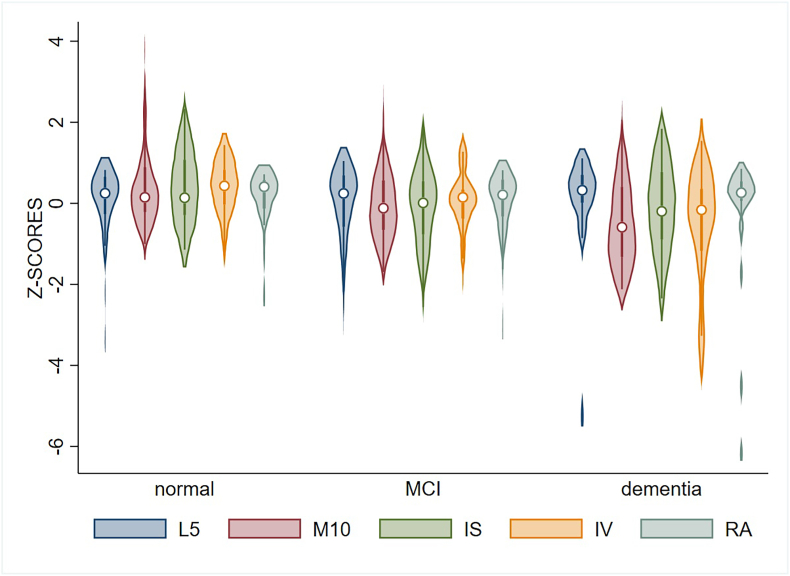睡眠之外:休息和活动节奏作为受教育程度较低的老年人临床前和轻度痴呆的标志。
Q2 Medicine
引用次数: 0
摘要
背景:虽然睡眠持续时间和睡眠相关呼吸障碍与痴呆症有关,但很少有研究调查昼夜节律关联与认知状态之间的关系。目的:探讨有认知障碍和受教育程度较低的老年人的休息和活动节奏与认知表现的关系。方法:对109例无痴呆诊断的老年社区居民进行腕部活动节律评价。每个参与者都完成了神经心理学测试,并被分类为认知障碍(MCI)、痴呆或正常认知。我们使用调整后的多项逻辑回归和线性回归模型分别将睡眠和昼夜节律非参数测量与认知组和认知z分数进行比较。结果:109例患者平均年龄为79.3±6.3岁,女性占74%,白人占68%,平均受教育年限为5.6±5.2年。日间活动强度与较好的语言能力相关(β = 0.178;95% ci = 0.022, 0.334;P = 0.03)和视觉空间表现(β = 0.158;95%ci = 0.008, 0.308;p = 0.04)。此外,更少的碎片节奏与更好的视觉空间相关(β = 0.172;95%ci = 0.025, 0.320;P = 0.02)和整体认知评分(β = 0.134;95%ci = 0.005, 0.263;p = 0.04)。每日间稳定性越高,轻度认知障碍和痴呆的风险越低(RR = 0.54;95%ci = 0.29-0.99;p = 0.04, RR = 0.44;95%ci = 0.21-0.94;P = 0.03)。此外,白天活动较多(RR = 0.40;95%ci = 0.18-0.89;p = 0.02)和较少的节律碎片化(RR = 0.31;95%ci = 0.14-0.73;P = 0.007)与痴呆风险降低相关。结论:受教育程度较低人群的日间活动强度和昼夜节律碎片化可能是认知功能障碍的重要标志。未来更大样本的研究应该会证实这些发现。本文章由计算机程序翻译,如有差异,请以英文原文为准。


Beyond sleep: Rest and activity rhythm as a marker of preclinical and mild dementia in older adults with less education
Background
Although sleep duration and sleep-related breathing disorders were associated with dementia previously, few studies examined the association between circadian rhythm association and cognitive status.
Objective
We aimed to investigate the association of rest and activity rhythm with cognitive performance in older people with cognitive complaints and less education.
Methods
Activity rhythm was evaluated with wrist actigraphy in 109 community-dwelling older people with cognitive complaints without diagnosed dementia. Each participant completed a neuropsychological battery and was classified as having cognitive impairment (MCI), dementia, or normal cognition. We used adjusted multinomial logistic regression and linear regression models to compare sleep and circadian non-parametric measures with cognitive groups and cognitive z-scores, respectively.
Results
The mean age of the 109 participants was 79.3 ± 6.3 years old, 74% were women, 68% were white, and the mean education was 5.6 ± 5.2 years. Daytime activity intensity was associated with better language (β = 0.178; 95% CI = 0.022, 0.334; p = 0.03) and visuospatial performance (β = 0.158; 95%CI = 0.008, 0.308; p = 0.04). Also, less fragmented rhythm was associated with better visuospatial (β = 0.172; 95%CI = 0.025, 0.320; p = 0.02) and global cognitive scores (β = 0.134; 95%CI = 0.005, 0.263; p = 0.04). More interdaily stability was associated with a lower risk of MCI and dementia (RR = 0.54; 95%CI = 0.29–0.99; p = 0.04, and RR = 0.44; 95%CI = 0.21–0.94; p = 0.03, respectively). Moreover, more daytime activity (RR = 0.40; 95%CI = 0.18–0.89; p = 0.02) and less rhythm fragmentation (RR = 0.31; 95%CI = 0.14–0.73; p = 0.007) were associated with lower risk for dementia.
Conclusion
Daytime activity intensity and fragmented rhythm during the day and night may play an important role as markers for cognitive impairment in less educated populations. Future studies with larger samples should confirm these findings.
求助全文
通过发布文献求助,成功后即可免费获取论文全文。
去求助
来源期刊

Neurobiology of Sleep and Circadian Rhythms
Neuroscience-Behavioral Neuroscience
CiteScore
4.50
自引率
0.00%
发文量
9
审稿时长
69 days
期刊介绍:
Neurobiology of Sleep and Circadian Rhythms is a multidisciplinary journal for the publication of original research and review articles on basic and translational research into sleep and circadian rhythms. The journal focuses on topics covering the mechanisms of sleep/wake and circadian regulation from molecular to systems level, and on the functional consequences of sleep and circadian disruption. A key aim of the journal is the translation of basic research findings to understand and treat sleep and circadian disorders. Topics include, but are not limited to: Basic and translational research, Molecular mechanisms, Genetics and epigenetics, Inflammation and immunology, Memory and learning, Neurological and neurodegenerative diseases, Neuropsychopharmacology and neuroendocrinology, Behavioral sleep and circadian disorders, Shiftwork, Social jetlag.
 求助内容:
求助内容: 应助结果提醒方式:
应助结果提醒方式:


